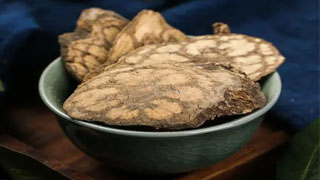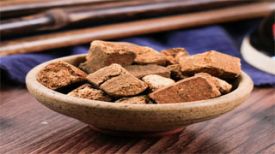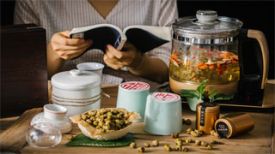
1. Aliases
Spicy Ziteng, Baogongteng, and Banyu Lie.2. Plant morphology
Tall woody vines. Twigs yellow green, with obvious edges, hairless. Leaves alternate, light red, leathery, elliptical or oblong ovate, blunt or blunt rounded at the top, gradually narrowed into a wedge-shaped base, with hairs on both sides, 4-7 pairs of lateral veins, slightly protruding on the back of the leaf, and raised in a network within the edge. Cyme, integrated with a panicle, axillary or terminal, inflorescence axis and peduncle covered with light brown pubescence; Calyx spherical, sepals nearly circular, covered with light brown pubescence, ciliate, hairs not forked; The corolla is white, and each lobe has a nearly triangular outer hairy petal band; 5 stamens, unequal in length, anthers and filaments nearly equal in length, with scales between filaments; The ovary is cylindrical, the stigma is conical, attached to the ovary, and the two are nearly equal in length. Berry oval shaped.
3. Origin distribution
Born in moist dense forests or roadside shrubs in valleys. Distributed in Guangdong, Hainan, Yunnan and other places.
4. Harvesting and processing
Harvest all year round, cut into sections or pieces, and sun dry.
5. Characteristics of medicinal herbs
Slanted section or slice. The outer skin is gray yellow, gray brown or light brown, slightly rough, with shallow grooves and irregular longitudinal cracks or turtle cracks. Skin pores are punctate or warty, yellow white in color. The old cork peels off in thin slices. Hard in texture, with a lot of fibers, not easy to break. The cut surface is elliptical, yellow brown or light yellow brown, with irregular vascular bundles in the shape of flowers or blocks, and xylem vessels in the shape of dots. Slight breath, light taste.
6. Nature, taste, and meridian tropism
Warm in nature and spicy in taste. Return to the stomach meridian, spleen meridian, and liver meridian.
7. Effect and function
Remove wind and dampness, reduce swelling and relieve pain. It belongs to the sub category of dispelling wind and dampness medicines and is classified as dispelling wind and dampness dispersing cold medicines.
8. Clinical applications
Dosage of 3-6 grams, prepare liquor, take orally or apply externally. Used to treat rheumatic pain, hemiplegia, falling and swelling pain, chronic rheumatoid arthritis, glaucoma, and various types of pain.
9. Pharmacological research
Ding Gong Teng has anti-inflammatory, pupil contraction, analgesic, and intraocular pressure reducing effects and effects, and can also relieve spasms; Promotes both cellular and humoral immunity; It has a function of improving the heart.
10. Chemical composition
Ding Gong Teng contains Bao Gong Teng Jia Su, Bao Gong Teng Bing Su, Aomai Ding Gong Teng alkaloid, scopolamine, scopolamine, as well as phenolic esters and organic amines. It also contains chemical components such as berberine, scopolamine lactone, and trace amounts of caffeic acid and chlorogenic acid. Ding Gong Teng alkaloid II can be used for identification of Ding Gong Teng.
11. Taboos for use
There is a small poison. This product has a strong sweating effect. It should be used with caution for weak individuals and avoided by pregnant women.
12. Compatibility prescription
① Rheumatism and pain, numbness in hands and feet: Ding Gong Teng, Gui Zhi, Zhi Zhi, Ma Huang, etc., soak in wine and take.
② Falling, swelling, and pain: soak the affected area in wine and apply it externally.
The content of the article is for clinical reference only. Non professionals in traditional Chinese medicine are not allowed to try medication.


